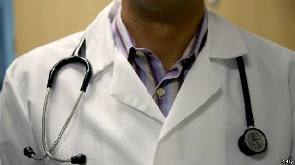A GNA feature by Albert Oppong-Ansah
GNA - Mr Yamale Sayibu, 52, the head of a family of 12 children and three wives was born and bred at Golinga a community in the Tolon/Kumbungu District of the Northern Region.
Although an illiterate Sayibu, he had enrolled all his children in school through proceeds of his farm, which has technically knockout abject poverty in his life, which was a torn in his flesh.
Sayibu told the Ghana News Agency, in an interview that his capacity in organic farming has also been built and it was his turning point of not only ending poverty but ensuring good nutrition for his entire family.
The organic farming venture was initiated by the Integrated Pest Management (IPM) for the promotion of sustainable integrated rice/fish farming under irrigation.
The project is being implemented by Presbyterian Farmers Training and Child Development Programme.
The organic farming success story had spread to many families living in Nahu, Gbelaligu and Galigbegu in the district.
Sayibu and other 55 people formed the farmer base organisation consisting 14 women and 41 men.
The IPM principles, underpin the participatory Farmer Field Schools approach for the implementation of proven and innovative technologies and strategies for affordable and improved organic farming, which include Improved Land preparation and Management for effective crop growth and development.
Others components are environmentally friendly water and soil conservation practices, Agro-ecosystem Analysis, understanding the plant, its environment, its pests and diseases, understanding crops pests and their dynamics, through regular observation and monitoring, in order to make the most appropriate interventions deemed necessary.
The project funded by the United Nations Development Programme and the Global Environmental Facility/ Small Grant Programme (GEF/SGP) aimed at empowering communities in and around the Golinga Irrigation Projects to improve their capacity to carry out sustainable and environmentally friendly integrated rice- fish farming enterprises.
It also assisted farmers to effectively use land and increase productivity as well as facilitate the growth and development of sustainable production and processing farmer Based Organisations termed small and medium enterprises.
The Project Officer, Mr Adam Heskaya briefing the GNA said the initiative was aimed at addressing the Millennium Development Goal (MDG) one, four and seven in the four communities.
Goal one stressed the need for countries signatory to the convention to eradicate extreme poverty and hunger while the seventh goal talks about ensuring environmental sustainability from 1990 to 2015.
With regards to goal one Ghana is largely on track in achieving the MDG 1 target of reducing by half the proportion of the population living in extreme poverty.
The overall poverty rate has declined substantially over the past two decades from 51.7 per cent in 1991/92 to 28.5 per cent 2005/2006, indicating that the target could be achieved ahead of the 2015 target of 26 per cent.
Similarly, the proportion of the population living below the extreme poverty line declined from 36.5 per cent to 18.2 per cent over the same period against the 2015 target of 19 per cent.
Even though the country is on track in achieving the target on halving the proportion without access to safe water, critical challenges exist in realising the targets of reversing the loss of environmental resources, reducing the proportion of people without access to improved sanitation, and achieving significant improvement in the lives of those living in slum areas.
Mr Heskyay noted that the technical back stopping was provided by the CSIR- Savannah Agricultural Research and the Water Research Institutes and in collaboration with the Ministry of Food and Agriculture.
Discussing the main activities, he said the first step was the rehabilitation of potential fish ponds and the landscape near the dam walls of the irrigation scheme during construction.
Measures Mr Heskyay said were put in place to mitigate lakeshore encroachment and erosion.
“We also established a demonstration rice-fish farms at the project sites and built the capacity of project beneficiaries in the development of Integrated Rural Small and Medium Enterprises around rice and fish products - rice and fish marketing study, operationalising of market information, profiling of buyers and marketing organisations and facilitation of formation of processing groups,” he said.
Periodically, he said, project workshops were organised to discuss and evaluate the findings of the pilot project with the view of the possibilities of making any needed adjustments, up scaling and replication.
At the end of the one year project there was a reduction in the use of chemical fertilisers by 50 per cent and the recycling of the nutrients by the fish through feeding and depositing of faeces in the soil. This increased the uptake of nutrients such as phosphorus and nitrogen by the rice.
He said there was an increase in rice yields because of fewer insects, better mineralisation, and distribution of nutrients, improved soil aeration and increased organic fertilisation.
One of the mile stone was also a reliable source of protein for farmers and their families, counteracting the decrease in available wild fish in many countries and contributing to a better diet for the farmer and his/her family.
He said a total of GH?3,560 was realised from the proceeds of the two fish ponds while
GH?5,780 was gained as proceeds for the rice farm.
Mr Ibrahim Abdellah 37- old farmer sharing his joy with the GNA said with the support and field education, he was able to harvest between 28 to 30 bags of rice from an acre of land.
I have been able to buy a motor bicycle and have saved money to prepare for the next farming season and also to take care of my family.
Mr George Ortsin, National Programme Coordinator of GEF/SGP in an interview with GNA expressed satisfaction about the impact of the project, adding that it had contributed to climate change adaptation.
He said adapting to climate change involves reducing exposure and sensitivity and increasing adaptive capacity.
On the success of the project he said, it had increased the community adaptive capacity and resilience to the adverse impacts of climate change. Even in time of droughts the communities are able to generate revenue from the sale of fish and rice.
“When there is climate induced droughts, the impact is made worse because usually there is no storage for previous year’s good harvest, however the community under the project have built a farm house which also serves as seed bank.
“Working in close collaboration with GEF/SGP technical support, the communities have learned to assess livelihood options according to the limited assets that they have access to natural assets such as the fishing grounds and rice fields; physical assets such as the dam to supply water regularly, human assets such as knowledge of local conditions; social assets including strong local user associations and family ties; and financial assets limited to sales of farm produce.
The people of the three northern Ghana could adapt to the negative effect of climate change such as drought if they offered resources such as dams to support irrigated farming and also equipped with the requisite knowledge on better farming.
Better late than never, time is not on the side of Ghana, so the country needs to act fast.
GNA
-- *Albert Oppong Ansah Environmental Journalist- * *Ghana News Agency * *ansahalbert@gmail.com* *Skyp: yawansah12 Mobile: + 233 242 586 646* *http://nanayaw1.wordpress.com/ * *
Opinions of Sunday, 18 March 2012
Columnist: Ansah, Albert Oppong






![Former President Akufo-Addo [L] and Okatakyie Afrifa Mensah Former President Akufo-Addo [L] and Okatakyie Afrifa Mensah](https://cdn.ghanaweb.com/imagelib/pics/587/58758132.295.jpg)











